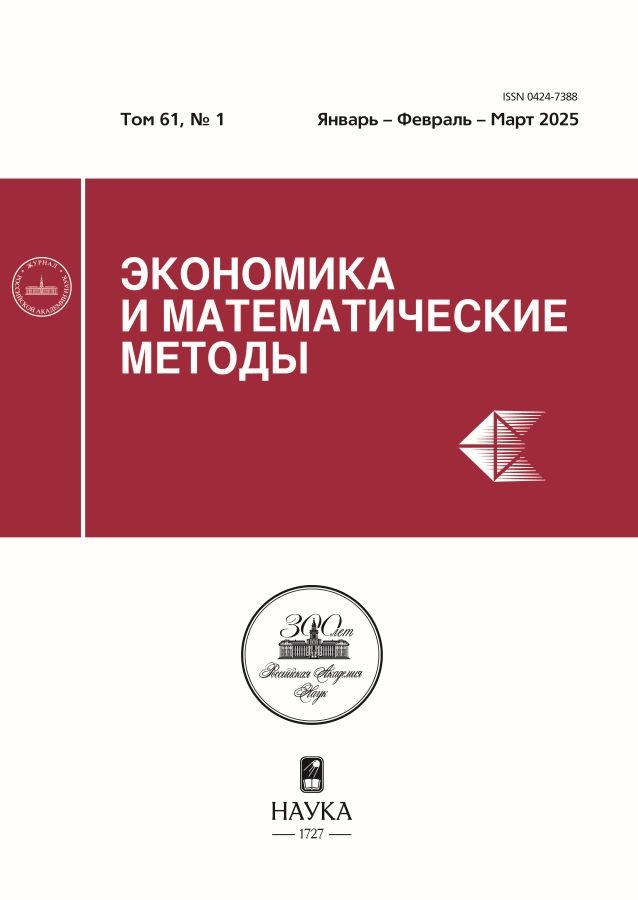Evolutionary nonstationarity of economic cycles
- Autores: Karmalita V.A.1, Khanian G.S.2
-
Afiliações:
- Private consultant
- CIAM named after P. I. Baranov
- Edição: Volume 61, Nº 1 (2025)
- Páginas: 18-24
- Seção: Theoretical and methodological problems
- URL: https://cardiosomatics.ru/0424-7388/article/view/682157
- DOI: https://doi.org/10.31857/S0424738825010026
- ID: 682157
Citar
Texto integral
Resumo
In the article, the nonstationarity of economic cycles is studied using their one-dimensional model of the “investment → income” type. The model interprets the cycle as random oscillations of an elastic system induced by exogenous (investment fluctuations) and endogenous (system properties) causes. This approach provided a quantitative description of economic cycles through the parameters of the elastic system — its natural frequency and damping factor. The nonstationarity of cycles is analyzed by the time trend of their natural frequencies. Such an analysis was performed for the period 1960–2020 by the amplitude spectra of US GDP deviations. Its results showed a simultaneous and steady decrease in the duration of the three considered cycles. This means that the results of observing these cycles do not have the ergodic property. Therefore, the adaptation of the cycle model to empirical data is possible for a time interval in which it can be considered pseudo-stationary.
Palavras-chave
Texto integral
Sobre autores
V. Karmalita
Private consultant
Autor responsável pela correspondência
Email: karmalita@videotron.ca
Canadá
G. Khanian
CIAM named after P. I. Baranov
Email: khanian@mail.ru
Senior researcher
Rússia, MoscowBibliografia
- Bolotin V. V. (1984). Random vibrations of elastic systems. Heidelberg: Springer. 468 p.
- Brandt S. (2014). Data analysis: Statistical and computational methods for scientists and engineers. 4th ed. Cham (Switzerland): Springer. 523 p.
- Cho S. (2018). Fourier transform and its applications using Microsoft EXCEL®. San Rafael (CA): Morgan & Claypool. 123 p.
- Cooley T. F., Prescott E. C. (1995). Economic growth and business cycles. In: Frontiers of business cycle research. T. F. Cooley (ed.). Princeton: Princeton University Press, 1–38.
- Karmalita V. (2020). Stochastic dynamics of economic cycles. Berlin: De Gruyter. 106 p.
- Karmalita V. A. (2023). Managing the prime rate to counter the cyclic income contraction. Economics and Mathematical Methods, 59 (3), 69–76. [Кармалита В. А. (2023). Managing the prime rate to counter the cyclic income contraction // Экономика и математические методы. Т. 59. № 3. С. 69–76.]
- Pain H. J. (2005). The physics of vibrations and waves. 6th ed. Chichester: John Wiley & Sons. 576 p.
- Pavleino M. A., Romadanov V. M. (2007). Spectral transforms in MATLAB®. St.-Petersburg: SPb SU. 160 p. (in Russian). [Павлейно М. А., Ромаданов В. М. (2007). Спектральные преобразования в MATLAB. Учебно-методическое пособие. Санкт-Петербург: Санкт-Петербургский государственный университет. 160 c.]
- Yamaguchi R., Islam M., Managi S. (2019). Inclusive wealth in the twenty-first century: A summary and further discussions of Inclusive Wealth Report 2018. Letters in Spatial and Resource Sciences, 12 (2), 101–111.
Arquivos suplementares




















